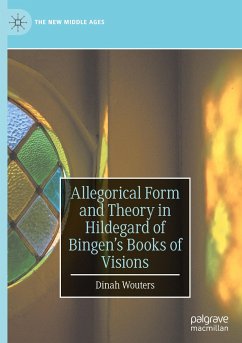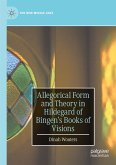Dinah Wouters
Allegorical Form and Theory in Hildegard of Bingen¿s Books of Visions
Dinah Wouters
Allegorical Form and Theory in Hildegard of Bingen¿s Books of Visions
- Gebundenes Buch
- Merkliste
- Auf die Merkliste
- Bewerten Bewerten
- Teilen
- Produkt teilen
- Produkterinnerung
- Produkterinnerung
This book analyses how the three books of visions by Hildegard of Bingen use the allegorical vision as a form of knowledge. It describes how the visionary's use of allegory and allegorical exegesis is linked to theories of cognition, interpretation, and prophecy. It argues that the form of the allegorical vision is not just the product of a medieval symbolic mentality, but specific to Hildegard's position and the major transformations taking place in the prescholastic intellectual milieu, such as the changing use of Scripture or the shift from traditional hermeneutics to cognitive language…mehr
Andere Kunden interessierten sich auch für
![Allegorical Form and Theory in Hildegard of Bingen¿s Books of Visions Allegorical Form and Theory in Hildegard of Bingen¿s Books of Visions]() Dinah WoutersAllegorical Form and Theory in Hildegard of Bingen¿s Books of Visions96,99 €
Dinah WoutersAllegorical Form and Theory in Hildegard of Bingen¿s Books of Visions96,99 €![Boccaccio the Philosopher Boccaccio the Philosopher]() Filippo AndreiBoccaccio the Philosopher63,99 €
Filippo AndreiBoccaccio the Philosopher63,99 €![Medieval Considerations of Incest, Marriage, and Penance Medieval Considerations of Incest, Marriage, and Penance]() Linda Marie RouillardMedieval Considerations of Incest, Marriage, and Penance63,99 €
Linda Marie RouillardMedieval Considerations of Incest, Marriage, and Penance63,99 €![Reading Illegitimacy in Early Iberian Literature Reading Illegitimacy in Early Iberian Literature]() Geraldine HazbunReading Illegitimacy in Early Iberian Literature37,99 €
Geraldine HazbunReading Illegitimacy in Early Iberian Literature37,99 €![Reading Illegitimacy in Early Iberian Literature Reading Illegitimacy in Early Iberian Literature]() Geraldine HazbunReading Illegitimacy in Early Iberian Literature37,99 €
Geraldine HazbunReading Illegitimacy in Early Iberian Literature37,99 €![Medieval Considerations of Incest, Marriage, and Penance Medieval Considerations of Incest, Marriage, and Penance]() Linda Marie RouillardMedieval Considerations of Incest, Marriage, and Penance63,99 €
Linda Marie RouillardMedieval Considerations of Incest, Marriage, and Penance63,99 €![Queenship in Medieval France, 1300-1500 Queenship in Medieval France, 1300-1500]() Murielle Gaude-FerraguQueenship in Medieval France, 1300-150066,99 €
Murielle Gaude-FerraguQueenship in Medieval France, 1300-150066,99 €-
-
-
This book analyses how the three books of visions by Hildegard of Bingen use the allegorical vision as a form of knowledge. It describes how the visionary's use of allegory and allegorical exegesis is linked to theories of cognition, interpretation, and prophecy. It argues that the form of the allegorical vision is not just the product of a medieval symbolic mentality, but specific to Hildegard's position and the major transformations taking place in the prescholastic intellectual milieu, such as the changing use of Scripture or the shift from traditional hermeneutics to cognitive language philosophy. The book shows that Hildegard uses traditional forms of knowledge - prophecy, the vision, monastic theology, allegorical hermeneutics - in startlingly innovative ways by combining them and by revising them for her own time.
Produktdetails
- Produktdetails
- The New Middle Ages
- Verlag: Palgrave Macmillan / Springer International Publishing / Springer, Berlin
- Artikelnr. des Verlages: 978-3-031-17191-8
- 1st ed. 2022
- Seitenzahl: 304
- Erscheinungstermin: 6. Dezember 2022
- Englisch
- Abmessung: 216mm x 153mm x 21mm
- Gewicht: 508g
- ISBN-13: 9783031171918
- ISBN-10: 3031171918
- Artikelnr.: 65261133
- The New Middle Ages
- Verlag: Palgrave Macmillan / Springer International Publishing / Springer, Berlin
- Artikelnr. des Verlages: 978-3-031-17191-8
- 1st ed. 2022
- Seitenzahl: 304
- Erscheinungstermin: 6. Dezember 2022
- Englisch
- Abmessung: 216mm x 153mm x 21mm
- Gewicht: 508g
- ISBN-13: 9783031171918
- ISBN-10: 3031171918
- Artikelnr.: 65261133
Dinah Wouters received her PhD in Latin literature from Ghent University, Belgium. She co-founded the research group RELICS and the open access journal JOLCEL, which promotes the study of Latin literature as a European literature. Her current project studies the impact of early modern Latin drama on a European scale.
1 Introduction.- Integumental Hermeneutics and Prescholastic Philosophy.- Allegory, Language, and Cognition.- Linking Allegorical Form to Allegorical Theory.-References.-2 Vision and Explanation.- Vision and Explanation.-The Function of the Allegory.-The Formal Interplay of Allegory and Allegoresis.- Allegory and Symbol.-References.-3 Allegory as Form and Concept.- Distinguishing Between Allegory and Allegoresis.-Prejudiced Distinctions in Modern Theory.-Blurred Distinctions in Medieval Hermeneutics.- Interactions Between Allegoresis and Allegory.-Allegory as Form: Figurative Language and Levels of Meaning.-Metaphor.- Pun.-Personification.-Metonymy.- Allegory as Idea: A Vital Belief and Conceptions of Allegory.-Language: Suprarealism and Self-Consciousness.-Reality: Fabulism and Figuralism.- Reversal of Values.-References.-4 Exegetical Form: The Eccentric Exegesis of the Homilies.-Creative Allegoresis in the Expositiones.-Multiple Interpretations and Narrative Continuity.- A Formal Definition for the Literal Level.-A Narrative Definition for the Senses of Scripture.-Creating a Narrative.- Exegetical Method: The Miraculous Catch of Allegory?.-The Allegoresis of the Expositionesand the Allegory of the Visions.-References.- 5 Allegorical form: Narrative, the Cosmos, and the End of Time.-The Narrative of the Parables.-The Reality of the Cosmos.- The Textuality of Visionary Reality.-The Reality of the Textual Cosmos.-The End of Time.- References.-6 Allegorical Cognition through Words.-Hildegard's Model of the Mind.- Other Models of Cognition.-The Circular Mind.-Perceptions as Cognitive Agents.- The Absence of Mental Images.-The Essential Role of Words.-The Promotion of Words Over Images.- Hildegard's Turn to Language.-Exegetical Cognition.-From Hermeneutics to Epistemology.- Allegorical Creation from Exegetical Method.-Glossing and Properties.-Allegorical Handbooks.- The Cognitive Dynamics of Reading Allegorically.-References.-7 Allegorical Revelation through Prophecy.- Allegorical Interpretation as an Essential Part of Revelation History.-The Old, the New, and the Interpretation of Each.-Allegory in Deeds and in Words.- Veils and Illumination.-Allegory and Forms of Prophecy.-Clarity, Obscurity, and Hildegard's Prophetic Goals.- Different Kinds of Prophecy in Hildegard's Works.-Cognition and Forms of Visionary Experience.-Augustine's Theory of Vision.- Hildegard's Visio Spiritualis/Intellectualis.-Augustine's Cognitive Visions.-The Continuity Between Vision and Cognition in Medieval Texts.- Becoming a Prophet.-The Prophet and the Reader.-References.- 8 Beliefs about Language and the Construction of Allegorical Form.-Allegorical Visions and Scripture.-Exceptional Language and the Reference to Nature.- Reversal of Allegory and Allegoresis.-Allegorical Form and Truth.-Allegorical Language.- The Origin and Fall of Language.-In Search of a Theological Language.-A Sphere of Literary Symbolism?.- Hildegard's Faith in Language.-Conclusion.-References.
1 Introduction.- Integumental Hermeneutics and Prescholastic Philosophy.- Allegory, Language, and Cognition.- Linking Allegorical Form to Allegorical Theory.-References.-2 Vision and Explanation.- Vision and Explanation.-The Function of the Allegory.-The Formal Interplay of Allegory and Allegoresis.- Allegory and Symbol.-References.-3 Allegory as Form and Concept.- Distinguishing Between Allegory and Allegoresis.-Prejudiced Distinctions in Modern Theory.-Blurred Distinctions in Medieval Hermeneutics.- Interactions Between Allegoresis and Allegory.-Allegory as Form: Figurative Language and Levels of Meaning.-Metaphor.- Pun.-Personification.-Metonymy.- Allegory as Idea: A Vital Belief and Conceptions of Allegory.-Language: Suprarealism and Self-Consciousness.-Reality: Fabulism and Figuralism.- Reversal of Values.-References.-4 Exegetical Form: The Eccentric Exegesis of the Homilies.-Creative Allegoresis in the Expositiones.-Multiple Interpretations and Narrative Continuity.- A Formal Definition for the Literal Level.-A Narrative Definition for the Senses of Scripture.-Creating a Narrative.- Exegetical Method: The Miraculous Catch of Allegory?.-The Allegoresis of the Expositionesand the Allegory of the Visions.-References.- 5 Allegorical form: Narrative, the Cosmos, and the End of Time.-The Narrative of the Parables.-The Reality of the Cosmos.- The Textuality of Visionary Reality.-The Reality of the Textual Cosmos.-The End of Time.- References.-6 Allegorical Cognition through Words.-Hildegard's Model of the Mind.- Other Models of Cognition.-The Circular Mind.-Perceptions as Cognitive Agents.- The Absence of Mental Images.-The Essential Role of Words.-The Promotion of Words Over Images.- Hildegard's Turn to Language.-Exegetical Cognition.-From Hermeneutics to Epistemology.- Allegorical Creation from Exegetical Method.-Glossing and Properties.-Allegorical Handbooks.- The Cognitive Dynamics of Reading Allegorically.-References.-7 Allegorical Revelation through Prophecy.- Allegorical Interpretation as an Essential Part of Revelation History.-The Old, the New, and the Interpretation of Each.-Allegory in Deeds and in Words.- Veils and Illumination.-Allegory and Forms of Prophecy.-Clarity, Obscurity, and Hildegard's Prophetic Goals.- Different Kinds of Prophecy in Hildegard's Works.-Cognition and Forms of Visionary Experience.-Augustine's Theory of Vision.- Hildegard's Visio Spiritualis/Intellectualis.-Augustine's Cognitive Visions.-The Continuity Between Vision and Cognition in Medieval Texts.- Becoming a Prophet.-The Prophet and the Reader.-References.- 8 Beliefs about Language and the Construction of Allegorical Form.-Allegorical Visions and Scripture.-Exceptional Language and the Reference to Nature.- Reversal of Allegory and Allegoresis.-Allegorical Form and Truth.-Allegorical Language.- The Origin and Fall of Language.-In Search of a Theological Language.-A Sphere of Literary Symbolism?.- Hildegard's Faith in Language.-Conclusion.-References.








